Supporter
In heraldry, supporters, sometimes referred to as attendants, are figures or objects usually placed on either side of the shield and depicted holding it up.
| Part of a series on |
| Heraldic achievement |
|---|
| External devices in addition to the central coat of arms |
|
|


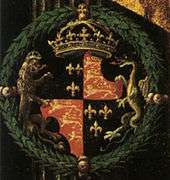
Early forms of supporters are found in medieval seals. However, unlike the coronet or helmet and crest, supporters were not part of early medieval heraldry. As part of the heraldic achievement, they first become fashionable towards the end of the 15th century, but even in the 17th century were not necessarily part of the full heraldic achievement (being absent, for example, in Siebmachers Wappenbuch of 1605).
The figures used as supporters may be based on real or imaginary animals, human figures, and in rare cases plants or other inanimate objects, such as the pillars of Hercules of the coat of arms of Spain. Often, as in other elements of heraldry, these can have local significance, such as the fisherman and the tin miner granted to Cornwall County Council, or a historical link; such as the lion of England and unicorn of Scotland in the two variations of the Coat of Arms of the United Kingdom. The arms of nutritionist John Boyd-Orr use two 'garbs' (wheat sheaves) as supporters; the arms of USS Donald Cook, missiles; the arms of the state of Rio Grande do Norte in Brazil, trees.[1] Letters of the alphabet are used as supporters in the arms of Valencia, Spain. Human supporters can also be allegorical figures, or, more rarely, specifically named individuals.[2]
There is usually one supporter on each side of the shield, though there are some examples of single supporters placed behind the shield, such as the imperial eagle of the coat of arms of the Holy Roman Empire. The coat of arms of the Republic of the Congo provide an extremely unusual example of two supporters issuing from behind the shield.[3] While such single supporters are generally eagles[4] with one or two heads, there are other examples, including the cathedra in the case of some Canadian cathedrals.[5] At the other extreme and even rarer, the Scottish chief Dundas of that Ilk had three supporters: two conventional red lions and the whole supported by a salamander. The coat of arms of Iceland even has four supporters.[6]
The context of the application of supporters may vary, although entitlement may be considered conditioned by grant of a type of augmentation of honour by admission in orders of chivalry or by heraldic authorities, such as in the case of traditional British heraldry.
Attitude
Animal supporters are, by default, as close to rampant as possible, if the nature of the supporter allows it (this does not need to be mentioned in the blazon), though there are some blazoned exceptions. An example of whales 'non-rampant' is the arms of the Dutch municipality of Zaanstad.[7]
Regional development and entitlement
Older writers trace origins of supporters to their usages in tournaments, where the shields of the combatants were exposed for inspection, and guarded by their servants or pages disguised in fanciful attire. However, medieval Scottish seals afford numerous examples in which the 13th and 14th century shields were placed between two creatures resembling lizards or dragons. Also, the seal of John, Duke of Normandy, eldest son of the King of France, before 1316 bears his arms as; France ancient, a bordure gules, between two lions rampant away from the shield, and an eagle with expanded wings standing above it.
Canada
In Canada, Companions of the Order of Canada, Commanders of the Order of Military Merit, Commanders of the Royal Victorian Order: people granted the style the Right Honourable, and corporations are granted the use of supporters on their coats of arms.[8][9] Further, on his retirement from office as Chief Herald, Robert Watt was granted supporters as an honour.[10]
France
In France, writers made a distinctive difference on the subject of supporters, giving the name of Supports to animals, real or imaginary, thus employed; while human figures or angels similarly used are called Tenants (i.e. 'holders'). Trees and other inanimate objects which are sometimes used are called Soutiens.
New Zealand
Knights Grand Companion and Principal Companions of the New Zealand Order of Merit are granted the use of heraldic supporters.[11]
United Kingdom
Originally, in England, supporters were regarded as little more than mere decorative and artistic appendages.
In the United Kingdom, supporters are typically an example of special royal favour, granted at the behest of the sovereign.[12] Hereditary supporters are normally limited to hereditary peers, certain members of the Royal Family, and to some chiefs of Scottish clans. Non-hereditary supporters are granted to life peers, Knights and Ladies of the Order of the Garter and Order of the Thistle, Knights and Dames Grand Cross of the Order of the Bath, Order of St Michael and St George, Royal Victorian Order and Order of the British Empire, and Bailiffs and Dames Grand Cross of the Order of St John. Knights banneret were also granted non-hereditary supporters, but no such knight has been created since the time of Charles I.
Supporters may also be granted to corporations which have a royal charter.
Examples
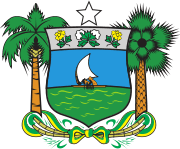 Two trees in the coat of arms of Rio Grande do Norte.
Two trees in the coat of arms of Rio Grande do Norte.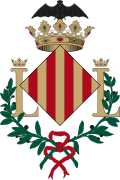 The two L's in the coat of arms of Valencia (city) mark it as 'doubly loyal'.
The two L's in the coat of arms of Valencia (city) mark it as 'doubly loyal'.- An angel is the single supporter of this Kraków sculpture of the arms of Poland.

.svg.png) Flags are the supporters in the arms of Supreme Headquarters Allied Powers Europe
Flags are the supporters in the arms of Supreme Headquarters Allied Powers Europe- Flags and cannons are the supporters in the arms of Kazimierz Raczyński
.svg.png) The coat of arms of Spain is supported by columns representing the Pillars of Hercules.
The coat of arms of Spain is supported by columns representing the Pillars of Hercules.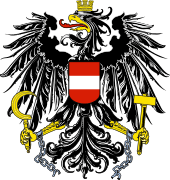 The coat of arms of Austria has one supporter, an eagle, which bears the escutcheon on its breast. This arrangement is common where eagles and other birds are used as supporters, as in the Great Seal of the United States and the coat of arms of Russia.
The coat of arms of Austria has one supporter, an eagle, which bears the escutcheon on its breast. This arrangement is common where eagles and other birds are used as supporters, as in the Great Seal of the United States and the coat of arms of Russia. The allegorical figures Liberty and blindfolded Justice support a shield on the flag of the State of New York
The allegorical figures Liberty and blindfolded Justice support a shield on the flag of the State of New York.jpeg)
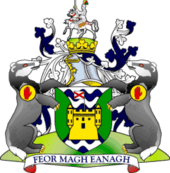 Badgers on the arms of County Fermanagh, Northern Ireland.
Badgers on the arms of County Fermanagh, Northern Ireland. The arms of South Georgia and the South Sandwich Islands feature a fur seal and macaroni penguin as supporters.
The arms of South Georgia and the South Sandwich Islands feature a fur seal and macaroni penguin as supporters.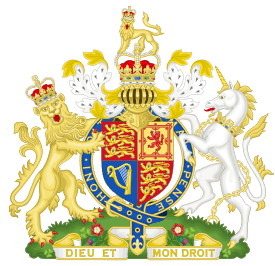 Royal arms of the United Kingdom (as used in England, Northern Ireland and Wales) has lion supporter (for England) in the dexter and unicorn supporter (for Scotland) in the sinister.
Royal arms of the United Kingdom (as used in England, Northern Ireland and Wales) has lion supporter (for England) in the dexter and unicorn supporter (for Scotland) in the sinister. Coat of Arms of Malaysia which has two tigers as the supporters.
Coat of Arms of Malaysia which has two tigers as the supporters..svg.png)
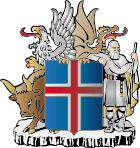 The coat of arms of Iceland is the only Nation to feature 4 supporters. Each supporter represents a protector and intercardinal direction. The bull is the protector of northwestern Iceland. The eagle or griffin is the protector of northeastern Iceland. The dragon is the protector of southeastern Iceland. The rock-giant is the protector of southwestern Iceland.
The coat of arms of Iceland is the only Nation to feature 4 supporters. Each supporter represents a protector and intercardinal direction. The bull is the protector of northwestern Iceland. The eagle or griffin is the protector of northeastern Iceland. The dragon is the protector of southeastern Iceland. The rock-giant is the protector of southwestern Iceland.
See also
References
| Wikimedia Commons has media related to Heraldic supporters. |
| Look up supporter in Wiktionary, the free dictionary. |
- "Rio Grande do Norte - Brasão de Rio Grande do Norte (coat of arms, crest)". www.ngw.nl. Retrieved 18 March 2018.
- "Flags of the World — Blumenau, Santa Catarina(Brazil)". fotw.net. Archived from the original on 25 July 2008. Retrieved 18 March 2018.
- "Heraldry of the world - Congo_(Brazzaville)". www.ngw.nl. Retrieved 18 March 2018.
- e.g. Perth & Kinross District Council (Scotland) at Heraldry of the World
- General, The Office of the Secretary to the Governor. "Saint Paul's Cathedral [Civil Institution]". archive.gg.ca. Retrieved 18 March 2018.
- Iceland at Heraldry of the World
- Zaanstad at Heraldry of the World
- A Canadian Heraldric Primer, p. 9
- McCreery, Christopher (2008). On Her Majesty's Service: Royal Honours and Recognition in Canada. Toronto: Dundurn Press. p. 76. Retrieved 28 April 2012.
- "Organizing The Term Paper – mbmpl". www.scotsheraldry.com. Retrieved 18 March 2018.
- "Statutes of the New Zealand Order of Merit (1996), article 50". legislation.govt.nz. Retrieved 8 December 2016.
- Charles Boutell and Arthur Charles Fox-Davies (2003). English Heraldry. Kessinger. p. 238. ISBN 0-7661-4917-X.CS1 maint: uses authors parameter (link)